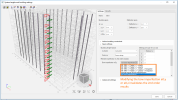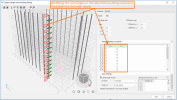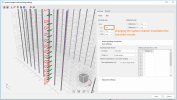Buckling settings that invalidate 2nd order results
The buckling settings allows the user to define local imperfections (bow imperfections) which are taken into account during a nonlinear analysis (i.e. 2nd order analysis). Changing these bow imperfections will invalidate the nonlinear results because the internal forces will no longer be correct. This is due to the fact that these bow imperfections cause additional moments as a consequence of the eccentricities they impose. Therefore a different eccentricity or bow imperfection will change the value of these additional moments in the members which requires a recalculation of the entire project.
Buckling settings that invalidate the non-linear results of a 2nd order analysis
Before mentioning what buckling settings invalidate the non-linear results of a 2nd order analysis it is important to mention what the main condition is for checking whether the 2nd order results are still valid or not. The main condition is defined in the non-linear combinations:
If the bow imperfection settings in the non-linear combinations are set to one of the two options below SCIA Engineer will start checking whether the 2nd order results are valid or not after a modification in the buckling settings:
- Simple curvature
- According to buckling data
1) Bow imperfection e0,y and e0,z
When modifying the bow imperfection settings e0,y and/or e0,z either in the dialog System lengths and buckling groups or in System lengths and buckling settings SCIA Engineer will delete the nonlinear results of a 2nd order analysis.
Also when using the bow imperfection setting e0,y or e0,z set to "manual input of bow imperfection" and you change the manual value of the bow imperfection in the table after the analysis --> nonlinear results of the 2nd order analysis will be deleted.
2) Active buckling constraints of y-y and z-z
When modifying the active buckling constraints (either via its table or by clicking on the red triangles of y-y- and/or z-z) in System lengths and buckling settings you are in essence modifying the span lengths and therefore indirectly also modifying the bow imperfection which means that the nonlinear results of the 2nd order analysis will be deleted.
For example if the bow imperfection was set to e0,y = L/200. Clearly you can see that when the span length L is modified you are indirectly also modifying the bow imperfection e0,y.
3) System relations
When modifying the system relations you are in essence changing the configuration of the active buckling constraints or with other words you are changing the span lengths. This will have the same effect as explained in point 2 therefore the nonlinear results of the 2nd order analysis will be deleted.
4) Switching buckling groups or assigning new buckling groups
The nonlinear results of the 2nd order analysis will be deleted when:
- Switching the buckling group of a given member from for example BG1 to BG2
- Assigning a buckling group to a given member (i.e. switching from default to for example BG1).
The reason why the buckling groups are deleted even when the settings mentioned in point 1, 2 and 3 are the same is because SCIA Engineer is not able to do the comparison in order to detect differences between both. It can only detect differences if an existing and already assigned buckling group is modified.





